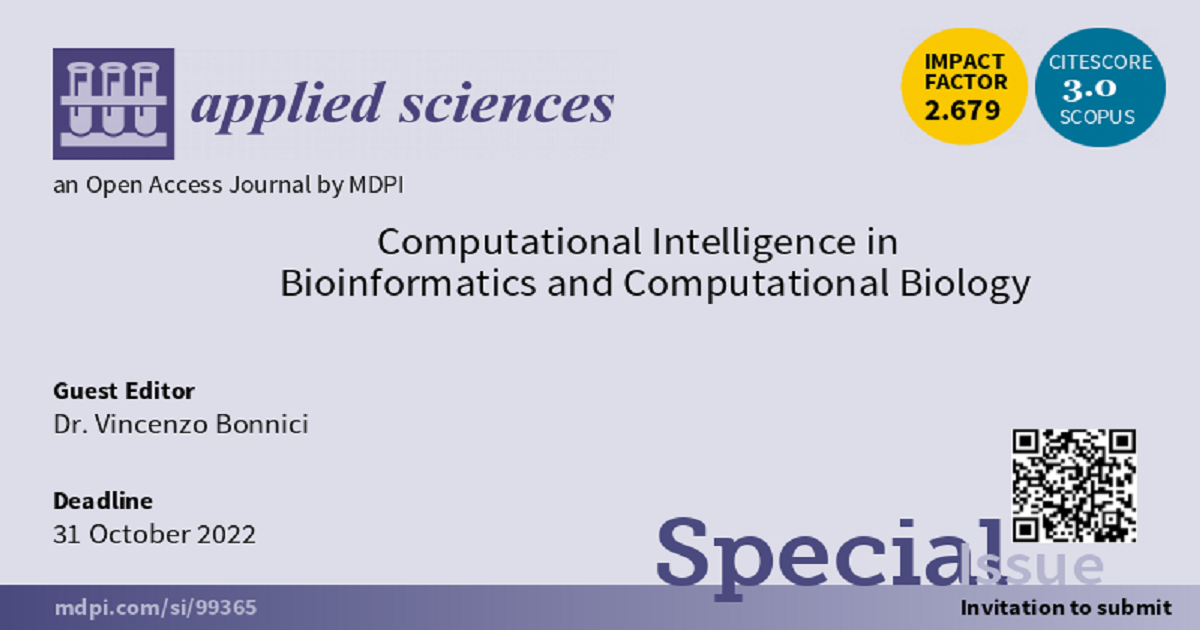Computational Intelligence in Bioinformatics and Computational Biology
A special issue of Applied Sciences (ISSN 2076-3417). This special issue belongs to the section "Computing and Artificial Intelligence".
Deadline for manuscript submissions: closed (31 October 2022) | Viewed by 8692

Special Issue Editor
Interests: computer science; bioinformatics; computational biology; parallel computing; graph theory; data integration
Special Issues, Collections and Topics in MDPI journals
Special Issue Information
Dear Colleagues,
Computational Intelligence (CI) is used in the area of bioinformatics (BI) for the purpose of advancing the area of computational niology (CB) and facilitating discoveries from biological data. Many methods, including fuzzy logic, neural networks, machine learning, and soft computing, could be applied to gene expression clustering and classification, protein function prediction and its structure, gene selection, and so on.
The aim of this Special Issue is to collect high-quality papers in related fields that clarify the applications of computational intelligence in bioinformatics and computational biology.
We invite researchers to contribute original research articles and reviews on several pertinent topics, including but not limited to:
- Bioinformatics;
- Computational biology;
- Algorithms and data structures;
- Graph theory;
- Parallel computing.
Dr. Vincenzo Bonnici
Guest Editor
Manuscript Submission Information
Manuscripts should be submitted online at www.mdpi.com by registering and logging in to this website. Once you are registered, click here to go to the submission form. Manuscripts can be submitted until the deadline. All submissions that pass pre-check are peer-reviewed. Accepted papers will be published continuously in the journal (as soon as accepted) and will be listed together on the special issue website. Research articles, review articles as well as short communications are invited. For planned papers, a title and short abstract (about 100 words) can be sent to the Editorial Office for announcement on this website.
Submitted manuscripts should not have been published previously, nor be under consideration for publication elsewhere (except conference proceedings papers). All manuscripts are thoroughly refereed through a single-blind peer-review process. A guide for authors and other relevant information for submission of manuscripts is available on the Instructions for Authors page. Applied Sciences is an international peer-reviewed open access semimonthly journal published by MDPI.
Please visit the Instructions for Authors page before submitting a manuscript. The Article Processing Charge (APC) for publication in this open access journal is 2400 CHF (Swiss Francs). Submitted papers should be well formatted and use good English. Authors may use MDPI's English editing service prior to publication or during author revisions.
Keywords
- bioinformatics
- computational biology
- algorithms and data structures
- graph theory
- parallel computing
Benefits of Publishing in a Special Issue
- Ease of navigation: Grouping papers by topic helps scholars navigate broad scope journals more efficiently.
- Greater discoverability: Special Issues support the reach and impact of scientific research. Articles in Special Issues are more discoverable and cited more frequently.
- Expansion of research network: Special Issues facilitate connections among authors, fostering scientific collaborations.
- External promotion: Articles in Special Issues are often promoted through the journal's social media, increasing their visibility.
- e-Book format: Special Issues with more than 10 articles can be published as dedicated e-books, ensuring wide and rapid dissemination.
Further information on MDPI's Special Issue policies can be found here.





